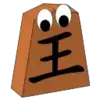Hi,
I have a question regarding the following position:
8/B7/7P/4p3/7k/8/2K5/b7 w - - 6 4
When you analyse this position with the integrated tablebase it shows two winning moves - Bd4 and Kb1.
I see that Bd4 is winning (although being unintuitive) but how does Kb1 win?
The tablebase itself is stating that
1. Kb1 Bc3
2. Kc2
is winning but to me it seems to be draw due to threefold repetition.
Is this a flaw in the tablebase or am I missing something here?
I have a question regarding the following position:
8/B7/7P/4p3/7k/8/2K5/b7 w - - 6 4
When you analyse this position with the integrated tablebase it shows two winning moves - Bd4 and Kb1.
I see that Bd4 is winning (although being unintuitive) but how does Kb1 win?
The tablebase itself is stating that
1. Kb1 Bc3
2. Kc2
is winning but to me it seems to be draw due to threefold repetition.
Is this a flaw in the tablebase or am I missing something here?
